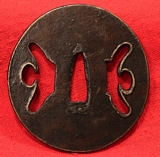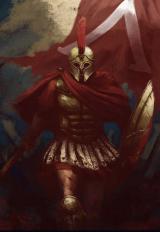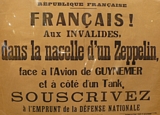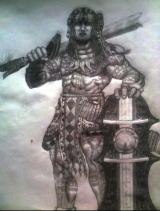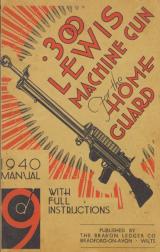Beautiful European Topographic Watercolour of A Castle on The Rhine 19th C.
In the British romantic landscape style, beautifully executed with fine skill, not far removed in quality by the greatest exponant of the art of watercolours, Joseph Mallord Willam Turner who is said laid the foundation for Impressionism. This is a beautiful Victorian English School watercolour, superbly executed. It is titled but unsigned, possibly by William Callow 1812-1908
Callow was a landscape, architectural and marine artist. He taught in Paris and was appointed drawing master to the family of Louis Phillippe who was King of France between 1830 and 1848. Callow was elected to the Royal Soc. of Painters in Water Colours in 1848. 7 X 9.5 inches, Frame 18.25 x 15.25 inches read more
675.00 GBP
A Very Scarce French Chassepot Rifle Musketoon Modele 1866 Colonial Inlay
Last used by the French Colonial Spahi in WW1. The scarce French Army Musketoon model, St Etienne. Converted to the Gras system in 1874. Used from the Franco Prussian war right throught WW1 by the French Colonial Spahi. This rifle was laterly renamed the 1866-74 after it was converted to the Gras system. Then in the latter part of its working life this rifle has been transferred to the French colonial troops, the famous Spahi, and over decoratedby them with typical Spahi flamboyant inlays at the butt. We show photos of a French Curassier using his 1866 Chassepot musketoon in the Franco Prussian War, French Infantry using their Chassepot, and the French Colonial Spahi using the 1866-74 musketoon into WW1.
Spahis were light cavalry regiments of the French army recruited primarily from the indigenous populations of Algeria, Tunisia and Morocco. The modern French Army retains one regiment of Spahis as an armoured unit, with personnel now recruited in mainland France. Senegal also maintains a mounted unit with spahi origins as a presidential escort: the Red Guard.he spahi regiments saw extensive service in the French conquest of Algeria, in the Franco-Prussian War, in Tonkin towards the end of the Sino-French War (1885), in the occupation of Morocco and Syria, and in both World Wars. A detachment of Spahis served as the personal escort of Marshal Jacques Leroy de Saint Arnaud in the Crimean War and were photographed there by Roger Fenton. A contingent of Spahis also participated in the North China campaign of 1860. During the Franco-Prussian War of 1870-71 one detached squadrons of Spahis formed part of the forces defending Paris, while a provisional regiment comprising three squadrons was attached to the Army of the Loire.[2] A serious rising against French rule in Algeria during 1871?72 was sparked off by the mutiny of a squadron of Spahis who had been ordered to France to reinforce those units already there. Pahis were sent to France at the outbreak of war in August 1914. They saw service during the opening period of mobile warfare but inevitably their role diminished with the advent of trench warfare. During World War I the number of units increased with the creation of Moroccan Spahi regiments and the expansion of the Algerian arm. By 1918 there were seven Spahi regiments then in existence, all having seen service on the Western Front, in addition a detached squadron had served in Palestine against the Ottoman Empire. 11mm calibre, .20+ inch barrel. Obsolete antique no licence required. Its inventor was, Antoine Alphonse Chassepot, and it became the French service weapon in 1866. It was first used at the battlefield at Mentana, November 1867, where it inflicted severe losses on Garibaldi's troops. The event was reported at the French Parliament: "Les Chassepots ont fait merveille!", {The Chassepots did marvelous execution !} In the Franco-Prussian War (1870-1871) it proved greatly superior to the German Dreyse needle gun, outranging it by 2 to 1. Although it was a smaller caliber but the chassepot ammunition had more gunpowder and thus faster muzzle velocity. The Chassepots were responsible for most of the Prussian and other German casualties during the conflict. Small Gras cartridge adaption bolt head lacking. As with all our antique guns no license is required as they are all unrestricted antique collectables read more
895.00 GBP
A Koto to Shinto Period Katana Tsuba In Iron Pierced With Stylized Birds
The piercing has been outlined with a borderline of inlaid brass. Circa 1600. Tsuba were made by whole dynasties of craftsmen whose only craft was making tsuba. They were usually lavishly decorated. In addition to being collectors items, they were often used as heirlooms, passed from one generation to the next. Japanese families with samurai roots sometimes have their family crest (mon) crafted onto a tsuba. Tsuba can be found in a variety of metals and alloys, including iron, steel, brass, copper and shakudo. In a duel, two participants may lock their katana together at the point of the tsuba and push, trying to gain a better position from which to strike the other down. This is known as tsubazeriai pushing tsuba against each other. read more
465.00 GBP
Wonderous Pieces Added Every Day & There is Probably Nowhere Else In The World You Can View Such Fabulous Wonders, & Where Everything Is For Sale
Under one roof, from a rare American Civil War Revolver used in the U.S. Navy, and by cavalry of both the North and the South. An Original, Huge, WW2 Shell from A German King Tiger Tank, to an Original Imperial Roman Legionary’s Gladius, to a Museum Quality Samurai Sword by on of the great makers of early Japan. These past three weeks we have added, and are still adding, original, ancient classical edged weapons, from Rome, Carthage, Persia, Greece, and Scandinavia, from fine English collection/s [acquired in the 1990’s or before] including; a 2000 year old gladius from the time of Julius Caesar to Augustus to Nero. A museum grade 1000+ year old Viking chieftain [king] or earl’s [jarl] sword inlaid with knotwork silver inlay. A bronze and iron Archemeanid sword from the time of the Greco-Persian wars of Xerxes the Great against the Spartans at Thermopylae. An Imperial Roman 1st century ring, the type as worn by the Imperial Pretorian Guard with the symbol of a lion, from the time of the Emperors Augustus, Tiberius, Caligula, Claudius and Nero. A superb 3rd to 4th century BC Falcata sword similar to the Greek Kopis, the sword used by Hannibal’s army in the 2nd Punic War and his invasion of Rome across the Alps, and a 3rd Century Imperial Roman Sword, from the time of Emperor Constantine and the Battle of Cibalae. Plus a remarkable 1066 period Original Norman Iron Four Plate Helmet, [as Seen Depicted in the world famous so-called Bayeux Tapestry] & two early Books, one, an original 5th century Roman treatise on Roman warfare, and 18th Century biography on 18th century Warfare. Plus, as usual, many more pieces of historical interest. read more
Price
on
Request
An Original French Bond Poster 1917-18. Subscribe to the National Defence
Francais aux invalides dans la narcelle d'un zeppelin face a l'avion de Guynemer et a cote d'un tank souscrivez a l'emprunt de la defense national. A poster of an exhibition at the great French museum Les Invalides. In the square in front of the museum there was exhibited; a narcelle from a shot down Zeppelin, WW1 French ace Guynemer's plane, and a tank. Backed on to linen, from the American Forbes Library. read more
265.00 GBP
A Simply Superb Master Conductor/Composer's Solid Silver Presentation Baton
For those with an interest in presentation pieces in the realm of musical memorabilia. Engraved 'Geisha', O.M. [Order of Merit] 25th April 1925. C.A.O.S. [Choral & Orchestra Society]. In mallacca and mounted in hallmarked solid silver. Presentation gifted to a composer/conductor who would have been a contemporary of Sir Edward Elgar O.M. Sadly, we know not to whom it may have been presented. However research in the right quarter may well bear fruit. Unscrews at the midsection into two pieces. Superb quality as one might expect. read more
185.00 GBP
A Good and Scarce Antique Malaysian Kampilan Sword
A rare tribal sword, somewhat crude but superbly effective in the terrain and jungles of the Philippines. The standard kampilan is a type of single-edged long sword, used in the Philippine islands of Mindanao, Visayas, and Luzon. This unusual variant has a long 33.5 inch double edged blade more reminiscant of a European broadsword, more similar to the sword of Datu Lapu-Lapu, legendary warrior Philippine king of the Mactan
The kampilan has a distinct profile, with the tapered blade being much broader and thinner at the point than at its base, sometimes with a protruding spikelet along the flat side of the tip and a bifurcated hilt which is believed to represent a mythical creature's open mouth.
The Maguindanao and the Maranao of mainland Mindanao preferred this weapon as opposed to the Tausug of Sulu who favoured the barung. The Kapampangan name of the Kampilan was "Talibong" and the hilt on the Talibong represented the dragon Naga, however the creature represented varies between different ethnic groups. Its use by the Illocanos have also been seen in various ancient records.
A notable wielder of the kampilan was Datu Lapu-Lapu (the king of Mactan) and his warriors, who defeated the Spaniards and killed Portuguese explorer Ferdinand Magellan at the Battle of Mactan on April 27, 1521.
The mention of the kampilan in ancient Filipino epics originating from other non-Muslim areas such as the Hiligaynon Hinilawod and the Ilocano Biag ni Lam-Ang is possible evidence for the sword's widespread usage throughout the archipelago during the ancient times. Today, the kampilan is portrayed in Filipino art and ancient tradition. The hilt is quite long in order to counterbalance the weight and length of the blade and is made of hardwood. As with the blade, the design of the hilt's profile is relatively consistent from blade to blade, combining to make the kampilan an effective combat weapon.
The complete tang of the kampilan disappears into a crossguard, which is often decoratively carved in an okir (geometric or flowing) pattern.The guard prevents the enemy's weapon from sliding all the way down the blade onto bearer's hand and also prevents the bearer's hand from sliding onto the blade while thrusting.
The most distinctive design element of the hilt is the Pommel, which is shaped to represent a creature's wide open mouth. The represented creature varies from sword to sword depending on the culture. Sometimes it is a real animal such as a monitor lizard or a crocodile, but more often the animal depicted is mythical, with the naga and the bakonawa being popular designs. Some kampilan also have animal or human hair tassels attached to the hilt as a form of decoration. read more
465.00 GBP
A Fabulous Imperial German Air Service Flask & Cigarette Case
This is just the epitome of all things Imperial German from the time of Kaiser Willhelm and Baron von Richthofen. The reservists flask was a peculiarly German artifact, and alongside the bier stein absolutely typical of the Germanic age of the early 20th century. The flask is an alloy depicting an embossed Zeppelin, an embossed plane and another, an anchor and a panel for luftschiff reserve service, and a similar for the flieger reserve service. It has a mono plane cup holder with a young pilot and his fraulein drinking and reveling. The front panel opens on a hinge revealing a picture behind the flask and a holder for cigarettes. It has wear and aging, but for the Imperial German WW1 reservist flask and stein collector you could probably not find a better or more desirable example. Overall 9 inches tall by 5 inches wide by 2 inches deep read more
395.00 GBP
Every Customer Should Expect & Will Receive Our World Renown 5* Star Service, Day In, Day Out, 365 Days of the Year
We have received the greatest honour of being described by almost every visitor to our store in Brighton, as possibly, the very best and most remarkable specialist shop in the country, if not the world. Our standards of personal service, honed through the generations for over 100 years, we hope, are second to none, and every possible effort is made to create the best possible atmosphere and assistance, for every single customer, be it for a single item, or hundreds, in person, or via our website.
No stone is left unturned in order to ensure every single customer’s buying or selling experience is a pleasure and a joy. Thankfully, dozens of you confirm this to us every single day, these days electronically, and for that we cannot thank you enough. Stay Healthy, Stay Safe. read more
Price
on
Request
Original Lewis & Vickers Machine Gun Crates
Just uncovered from long-term storage in our gun room, acquired over the past 50 to 60 years.
Original Lewis and Vickers machine-gun transit cases. Designed and constructed by the British ordnance and made to exacting standards, to suffer the vagaries and exertions of wartime combat on the front line, and storage of machine guns for up to, and over, 100 years. Solid wood with all metal edge strengthening supports. They were designed to be thrown around and heavily manhandled on the backs of army trucks, tanks, and armoured vehicles in combat war situations, even to be dropped out of planes for arms supply drops behind enemy lines, they are incredibly strong.
Beautifully designed constructed and perfect for storage, and historical collectors. Also absolutely ideal for a deactivated Lewis or Vickers machine gun collectors to complete historical display.
***Available for UK collection only***. They are available for collection from our Brighton gun shop on a click and collect basis by appointment. Please telephone or email for details. They are simply incredible value probably couldn’t be made for 10 times the price. Call 07721 010085. We have seen these sell for over £200 each in the past, when they have been rarely available
We also have some Bren gun cases And Russian USSR maxim machine-gun transit cases. Some are stencilled others are plain. We do not have any of the actual guns available for sale at present. read more
90.00 GBP




